Comprehensive Business Research Report on Cloud Computing in Australia
VerifiedAdded on 2020/03/04
|13
|3053
|38
Report
AI Summary
This business research report examines the impact of cloud computing on Australian businesses, particularly within the retail sector. It begins with an introduction outlining the significance of cloud computing and its revolutionary impact on business operations. The report defines the project's objectives, which include identifying effective cloud data storage methods, evaluating the impact of cloud computing on retail organizations, assessing security measures, and recommending improvements. The scope encompasses the benefits of cloud computing, such as bandwidth management and disaster recovery, while also acknowledging drawbacks like bandwidth costs and potential data access limitations. A comprehensive literature review explores cloud computing's advantages like improved infrastructure and cost reduction, and disadvantages like data security concerns. The research establishes a hypothesis, poses key research questions, and details the research design and methodology, including qualitative and quantitative methods, sampling, data collection, and analysis techniques like interviews and questionnaires. The report also acknowledges limitations, such as time constraints. The report aims to provide insights into cloud computing's effectiveness and challenges, offering recommendations for enhanced implementation within the Australian retail sector.
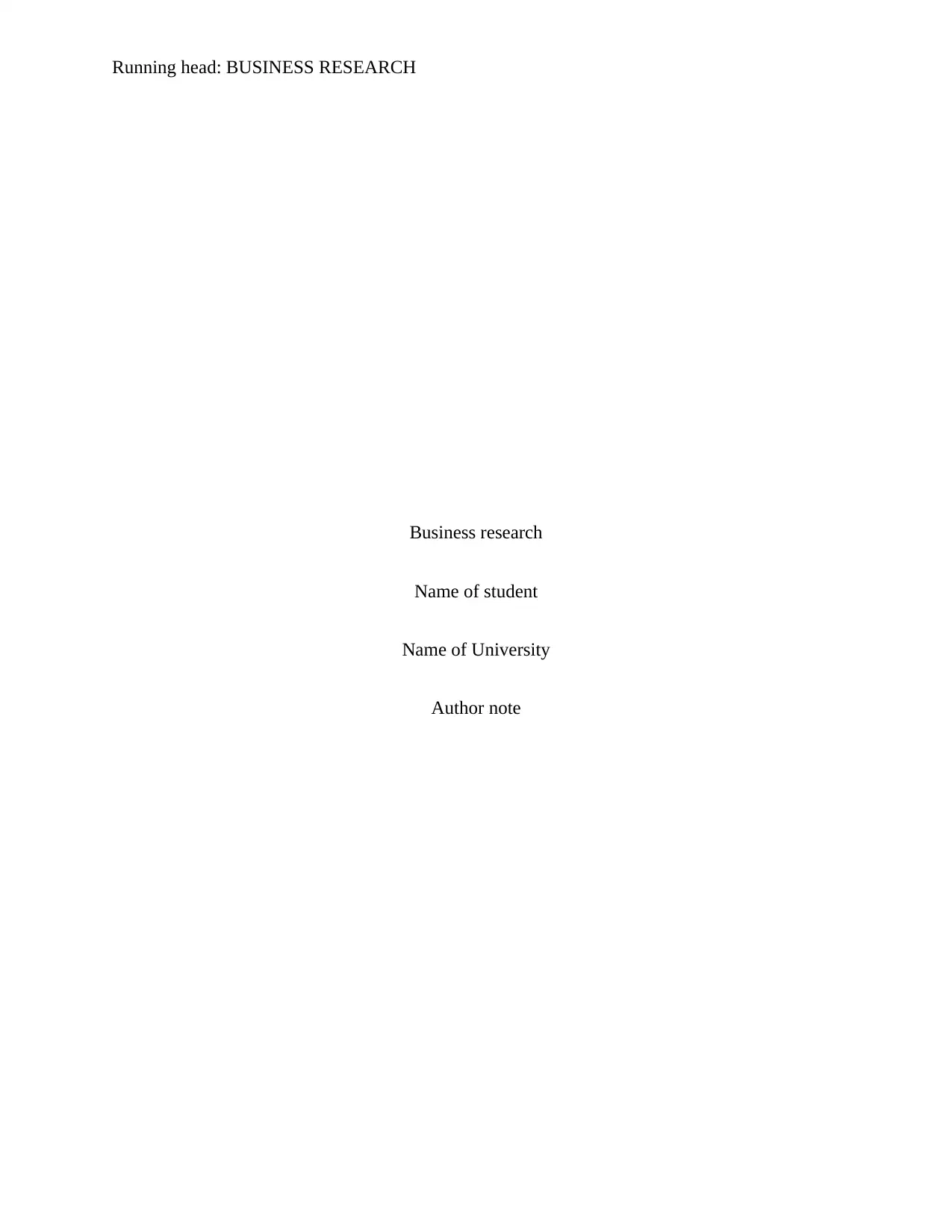
Running head: BUSINESS RESEARCH
Business research
Name of student
Name of University
Author note
Business research
Name of student
Name of University
Author note
Paraphrase This Document
Need a fresh take? Get an instant paraphrase of this document with our AI Paraphraser
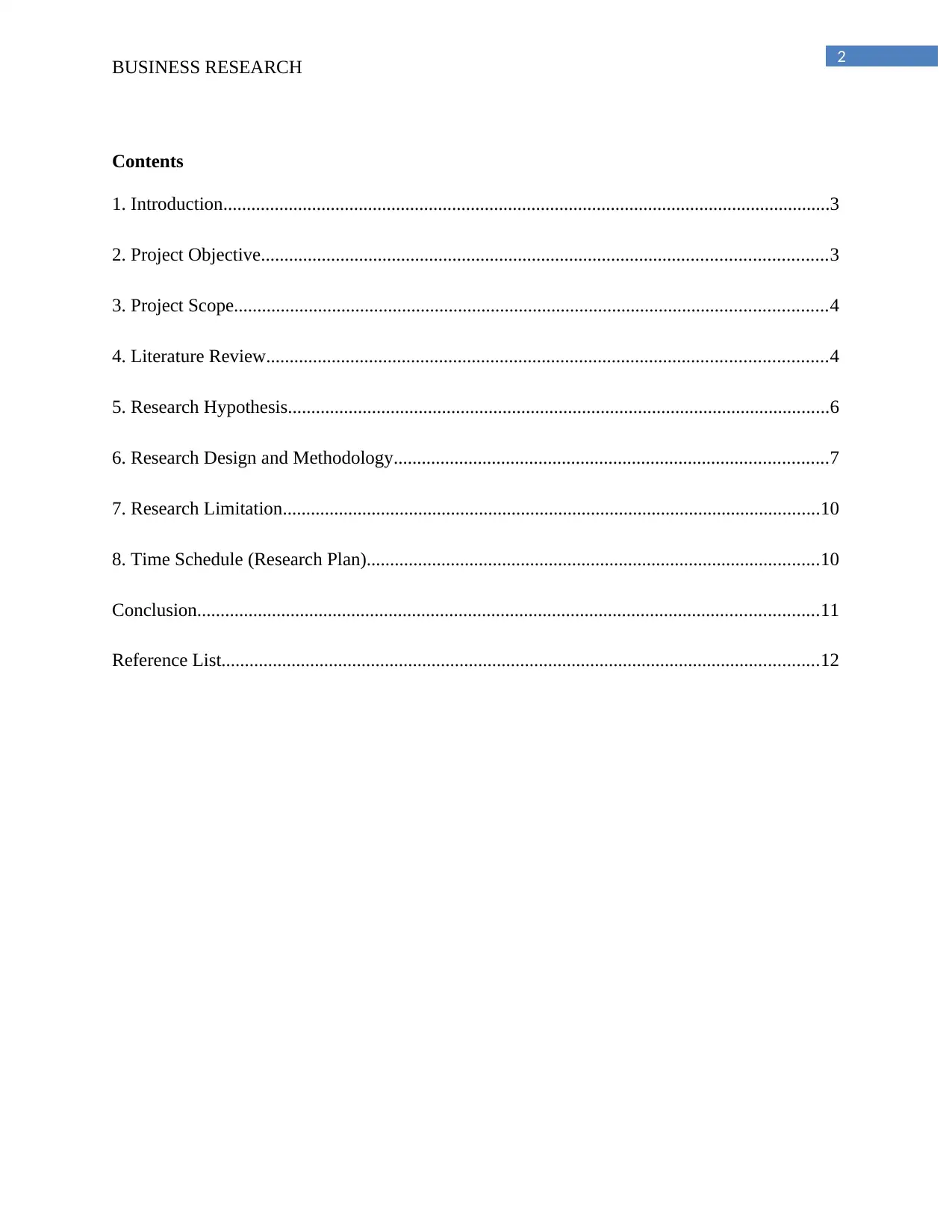
2
BUSINESS RESEARCH
Contents
1. Introduction..................................................................................................................................3
2. Project Objective.........................................................................................................................3
3. Project Scope...............................................................................................................................4
4. Literature Review........................................................................................................................4
5. Research Hypothesis....................................................................................................................6
6. Research Design and Methodology.............................................................................................7
7. Research Limitation...................................................................................................................10
8. Time Schedule (Research Plan).................................................................................................10
Conclusion.....................................................................................................................................11
Reference List................................................................................................................................12
BUSINESS RESEARCH
Contents
1. Introduction..................................................................................................................................3
2. Project Objective.........................................................................................................................3
3. Project Scope...............................................................................................................................4
4. Literature Review........................................................................................................................4
5. Research Hypothesis....................................................................................................................6
6. Research Design and Methodology.............................................................................................7
7. Research Limitation...................................................................................................................10
8. Time Schedule (Research Plan).................................................................................................10
Conclusion.....................................................................................................................................11
Reference List................................................................................................................................12
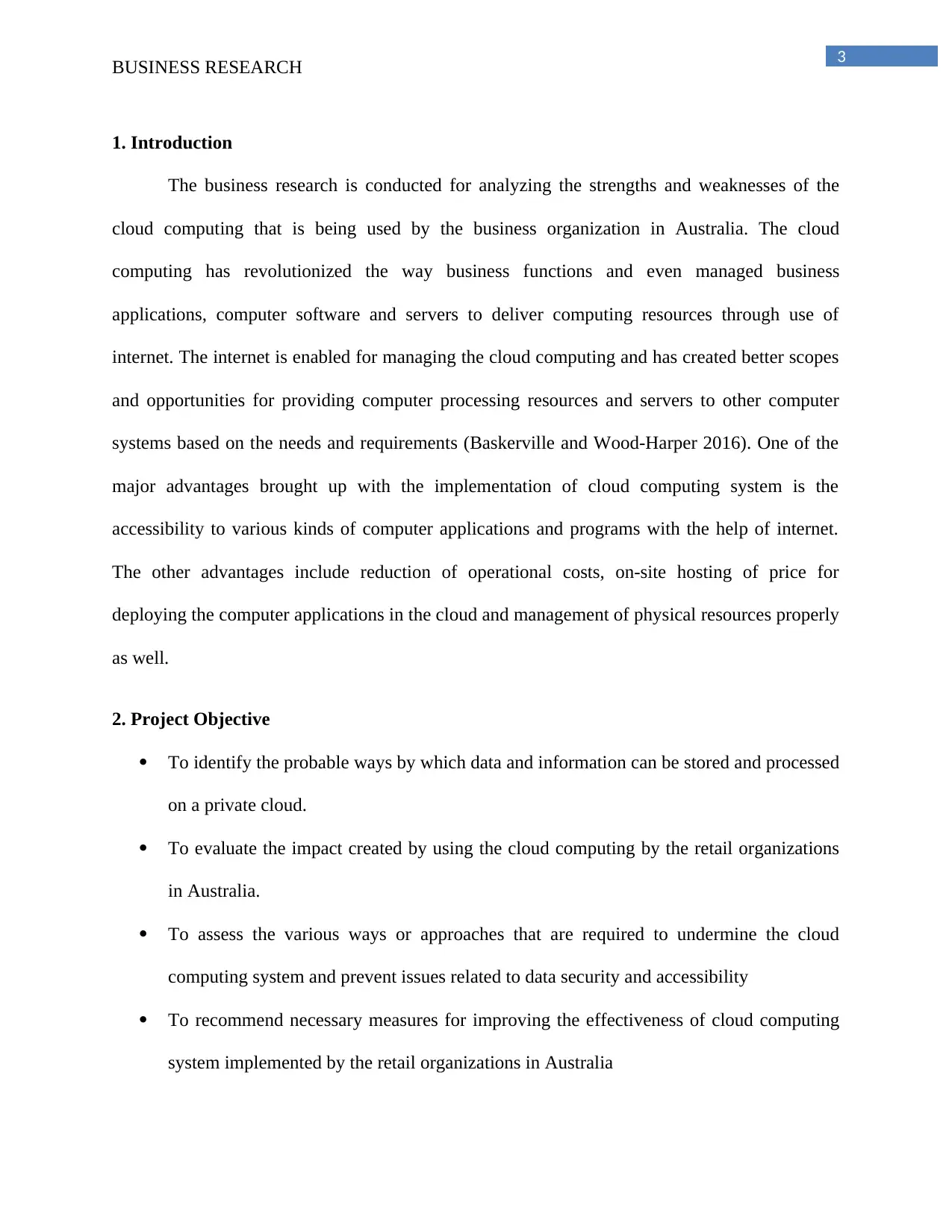
3
BUSINESS RESEARCH
1. Introduction
The business research is conducted for analyzing the strengths and weaknesses of the
cloud computing that is being used by the business organization in Australia. The cloud
computing has revolutionized the way business functions and even managed business
applications, computer software and servers to deliver computing resources through use of
internet. The internet is enabled for managing the cloud computing and has created better scopes
and opportunities for providing computer processing resources and servers to other computer
systems based on the needs and requirements (Baskerville and Wood-Harper 2016). One of the
major advantages brought up with the implementation of cloud computing system is the
accessibility to various kinds of computer applications and programs with the help of internet.
The other advantages include reduction of operational costs, on-site hosting of price for
deploying the computer applications in the cloud and management of physical resources properly
as well.
2. Project Objective
To identify the probable ways by which data and information can be stored and processed
on a private cloud.
To evaluate the impact created by using the cloud computing by the retail organizations
in Australia.
To assess the various ways or approaches that are required to undermine the cloud
computing system and prevent issues related to data security and accessibility
To recommend necessary measures for improving the effectiveness of cloud computing
system implemented by the retail organizations in Australia
BUSINESS RESEARCH
1. Introduction
The business research is conducted for analyzing the strengths and weaknesses of the
cloud computing that is being used by the business organization in Australia. The cloud
computing has revolutionized the way business functions and even managed business
applications, computer software and servers to deliver computing resources through use of
internet. The internet is enabled for managing the cloud computing and has created better scopes
and opportunities for providing computer processing resources and servers to other computer
systems based on the needs and requirements (Baskerville and Wood-Harper 2016). One of the
major advantages brought up with the implementation of cloud computing system is the
accessibility to various kinds of computer applications and programs with the help of internet.
The other advantages include reduction of operational costs, on-site hosting of price for
deploying the computer applications in the cloud and management of physical resources properly
as well.
2. Project Objective
To identify the probable ways by which data and information can be stored and processed
on a private cloud.
To evaluate the impact created by using the cloud computing by the retail organizations
in Australia.
To assess the various ways or approaches that are required to undermine the cloud
computing system and prevent issues related to data security and accessibility
To recommend necessary measures for improving the effectiveness of cloud computing
system implemented by the retail organizations in Australia
⊘ This is a preview!⊘
Do you want full access?
Subscribe today to unlock all pages.

Trusted by 1+ million students worldwide
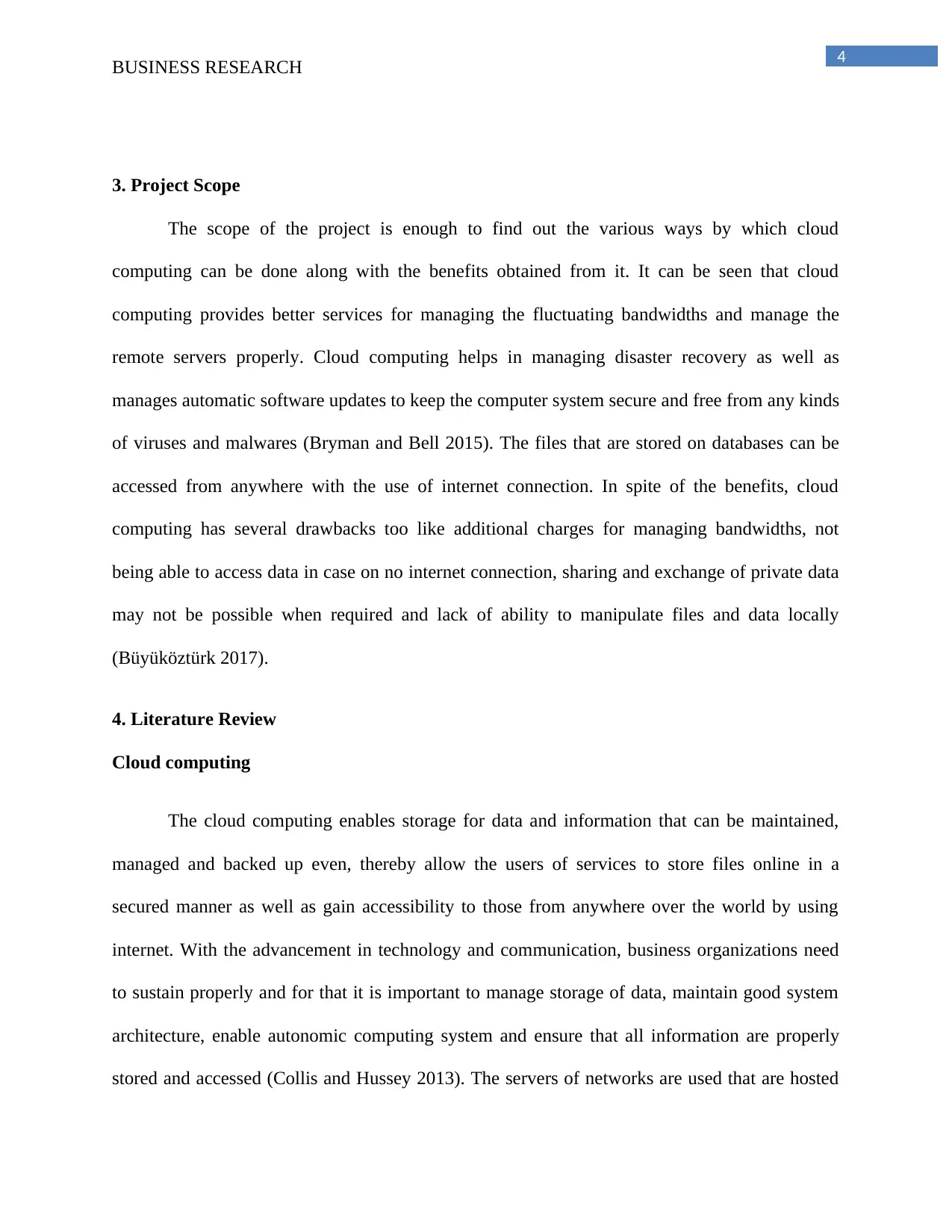
4
BUSINESS RESEARCH
3. Project Scope
The scope of the project is enough to find out the various ways by which cloud
computing can be done along with the benefits obtained from it. It can be seen that cloud
computing provides better services for managing the fluctuating bandwidths and manage the
remote servers properly. Cloud computing helps in managing disaster recovery as well as
manages automatic software updates to keep the computer system secure and free from any kinds
of viruses and malwares (Bryman and Bell 2015). The files that are stored on databases can be
accessed from anywhere with the use of internet connection. In spite of the benefits, cloud
computing has several drawbacks too like additional charges for managing bandwidths, not
being able to access data in case on no internet connection, sharing and exchange of private data
may not be possible when required and lack of ability to manipulate files and data locally
(Büyüköztürk 2017).
4. Literature Review
Cloud computing
The cloud computing enables storage for data and information that can be maintained,
managed and backed up even, thereby allow the users of services to store files online in a
secured manner as well as gain accessibility to those from anywhere over the world by using
internet. With the advancement in technology and communication, business organizations need
to sustain properly and for that it is important to manage storage of data, maintain good system
architecture, enable autonomic computing system and ensure that all information are properly
stored and accessed (Collis and Hussey 2013). The servers of networks are used that are hosted
BUSINESS RESEARCH
3. Project Scope
The scope of the project is enough to find out the various ways by which cloud
computing can be done along with the benefits obtained from it. It can be seen that cloud
computing provides better services for managing the fluctuating bandwidths and manage the
remote servers properly. Cloud computing helps in managing disaster recovery as well as
manages automatic software updates to keep the computer system secure and free from any kinds
of viruses and malwares (Bryman and Bell 2015). The files that are stored on databases can be
accessed from anywhere with the use of internet connection. In spite of the benefits, cloud
computing has several drawbacks too like additional charges for managing bandwidths, not
being able to access data in case on no internet connection, sharing and exchange of private data
may not be possible when required and lack of ability to manipulate files and data locally
(Büyüköztürk 2017).
4. Literature Review
Cloud computing
The cloud computing enables storage for data and information that can be maintained,
managed and backed up even, thereby allow the users of services to store files online in a
secured manner as well as gain accessibility to those from anywhere over the world by using
internet. With the advancement in technology and communication, business organizations need
to sustain properly and for that it is important to manage storage of data, maintain good system
architecture, enable autonomic computing system and ensure that all information are properly
stored and accessed (Collis and Hussey 2013). The servers of networks are used that are hosted
Paraphrase This Document
Need a fresh take? Get an instant paraphrase of this document with our AI Paraphraser
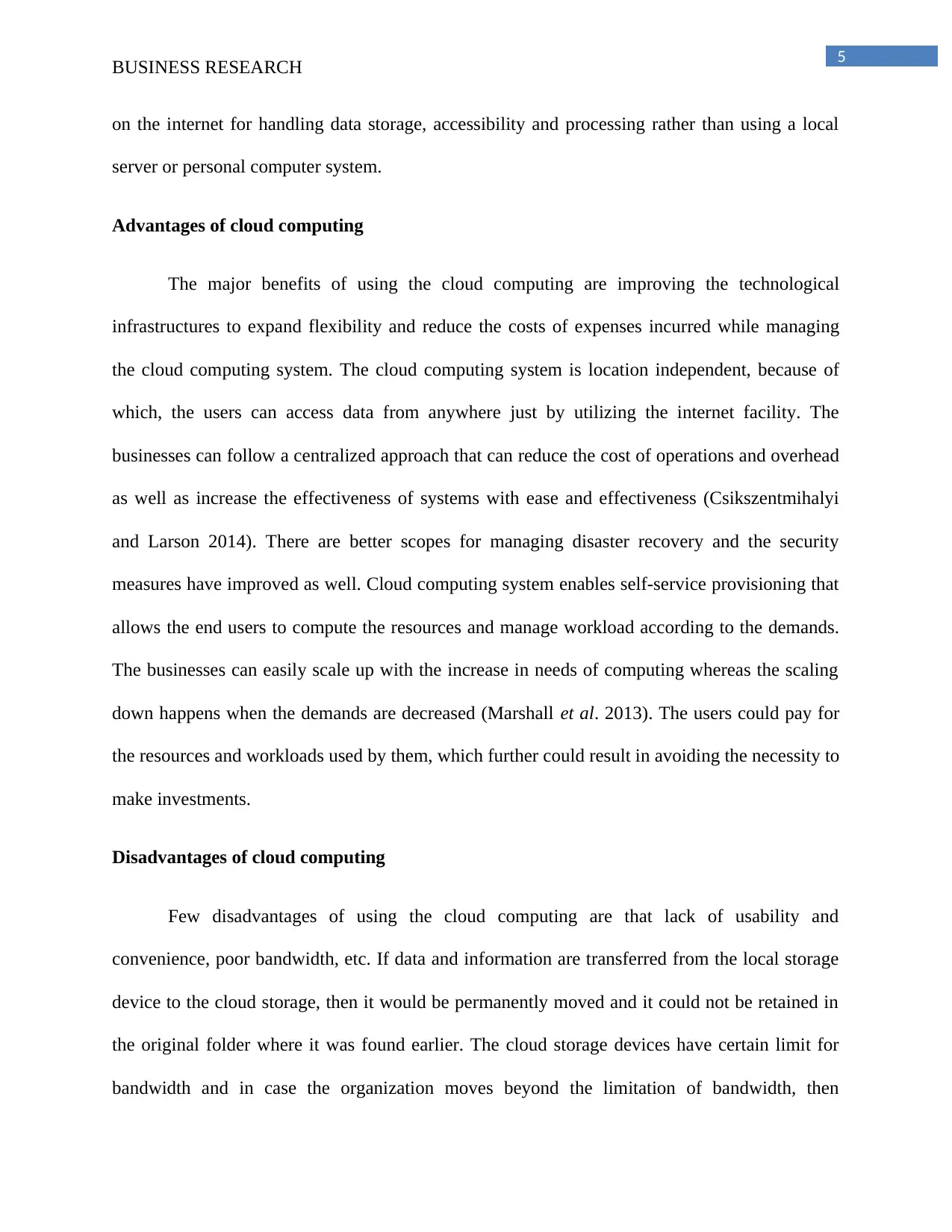
5
BUSINESS RESEARCH
on the internet for handling data storage, accessibility and processing rather than using a local
server or personal computer system.
Advantages of cloud computing
The major benefits of using the cloud computing are improving the technological
infrastructures to expand flexibility and reduce the costs of expenses incurred while managing
the cloud computing system. The cloud computing system is location independent, because of
which, the users can access data from anywhere just by utilizing the internet facility. The
businesses can follow a centralized approach that can reduce the cost of operations and overhead
as well as increase the effectiveness of systems with ease and effectiveness (Csikszentmihalyi
and Larson 2014). There are better scopes for managing disaster recovery and the security
measures have improved as well. Cloud computing system enables self-service provisioning that
allows the end users to compute the resources and manage workload according to the demands.
The businesses can easily scale up with the increase in needs of computing whereas the scaling
down happens when the demands are decreased (Marshall et al. 2013). The users could pay for
the resources and workloads used by them, which further could result in avoiding the necessity to
make investments.
Disadvantages of cloud computing
Few disadvantages of using the cloud computing are that lack of usability and
convenience, poor bandwidth, etc. If data and information are transferred from the local storage
device to the cloud storage, then it would be permanently moved and it could not be retained in
the original folder where it was found earlier. The cloud storage devices have certain limit for
bandwidth and in case the organization moves beyond the limitation of bandwidth, then
BUSINESS RESEARCH
on the internet for handling data storage, accessibility and processing rather than using a local
server or personal computer system.
Advantages of cloud computing
The major benefits of using the cloud computing are improving the technological
infrastructures to expand flexibility and reduce the costs of expenses incurred while managing
the cloud computing system. The cloud computing system is location independent, because of
which, the users can access data from anywhere just by utilizing the internet facility. The
businesses can follow a centralized approach that can reduce the cost of operations and overhead
as well as increase the effectiveness of systems with ease and effectiveness (Csikszentmihalyi
and Larson 2014). There are better scopes for managing disaster recovery and the security
measures have improved as well. Cloud computing system enables self-service provisioning that
allows the end users to compute the resources and manage workload according to the demands.
The businesses can easily scale up with the increase in needs of computing whereas the scaling
down happens when the demands are decreased (Marshall et al. 2013). The users could pay for
the resources and workloads used by them, which further could result in avoiding the necessity to
make investments.
Disadvantages of cloud computing
Few disadvantages of using the cloud computing are that lack of usability and
convenience, poor bandwidth, etc. If data and information are transferred from the local storage
device to the cloud storage, then it would be permanently moved and it could not be retained in
the original folder where it was found earlier. The cloud storage devices have certain limit for
bandwidth and in case the organization moves beyond the limitation of bandwidth, then
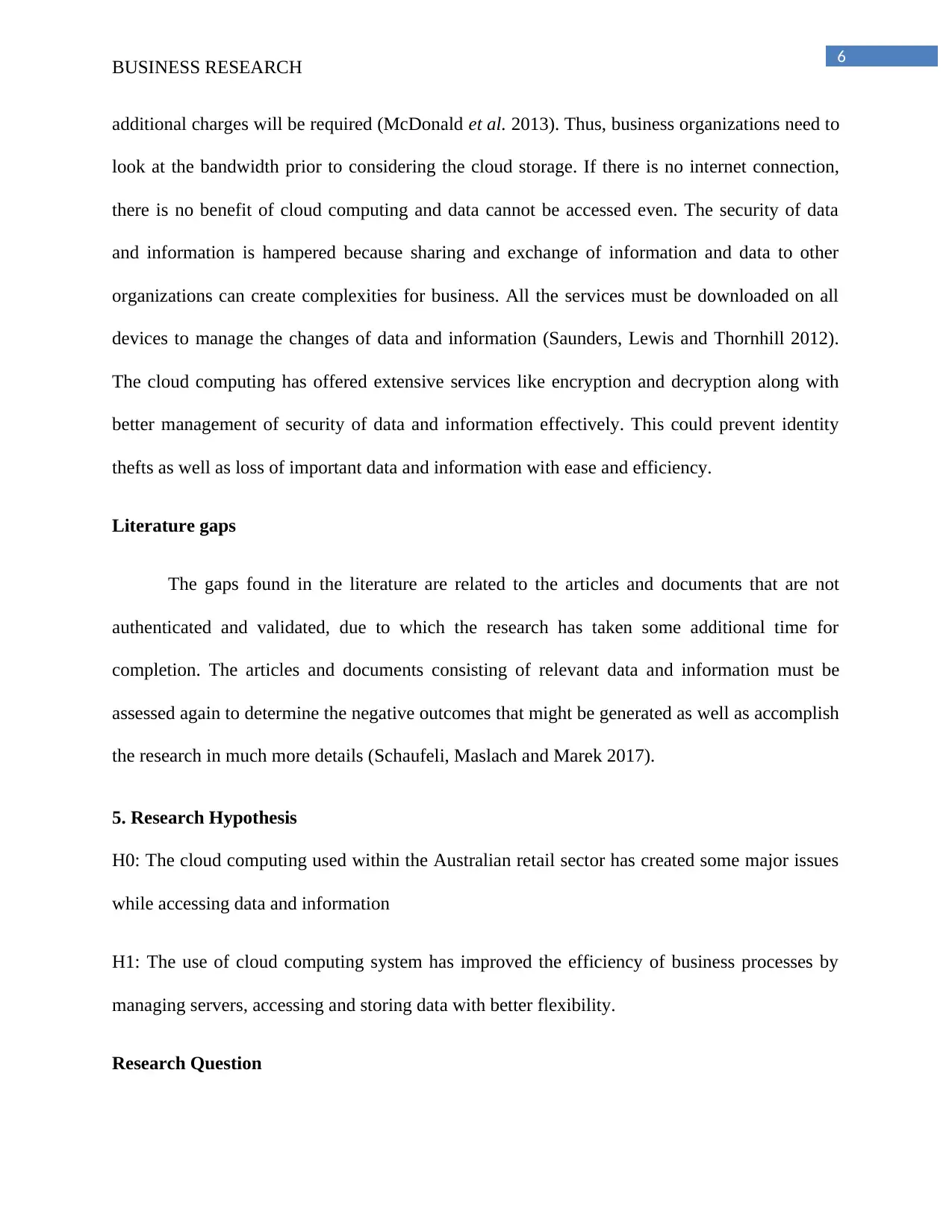
6
BUSINESS RESEARCH
additional charges will be required (McDonald et al. 2013). Thus, business organizations need to
look at the bandwidth prior to considering the cloud storage. If there is no internet connection,
there is no benefit of cloud computing and data cannot be accessed even. The security of data
and information is hampered because sharing and exchange of information and data to other
organizations can create complexities for business. All the services must be downloaded on all
devices to manage the changes of data and information (Saunders, Lewis and Thornhill 2012).
The cloud computing has offered extensive services like encryption and decryption along with
better management of security of data and information effectively. This could prevent identity
thefts as well as loss of important data and information with ease and efficiency.
Literature gaps
The gaps found in the literature are related to the articles and documents that are not
authenticated and validated, due to which the research has taken some additional time for
completion. The articles and documents consisting of relevant data and information must be
assessed again to determine the negative outcomes that might be generated as well as accomplish
the research in much more details (Schaufeli, Maslach and Marek 2017).
5. Research Hypothesis
H0: The cloud computing used within the Australian retail sector has created some major issues
while accessing data and information
H1: The use of cloud computing system has improved the efficiency of business processes by
managing servers, accessing and storing data with better flexibility.
Research Question
BUSINESS RESEARCH
additional charges will be required (McDonald et al. 2013). Thus, business organizations need to
look at the bandwidth prior to considering the cloud storage. If there is no internet connection,
there is no benefit of cloud computing and data cannot be accessed even. The security of data
and information is hampered because sharing and exchange of information and data to other
organizations can create complexities for business. All the services must be downloaded on all
devices to manage the changes of data and information (Saunders, Lewis and Thornhill 2012).
The cloud computing has offered extensive services like encryption and decryption along with
better management of security of data and information effectively. This could prevent identity
thefts as well as loss of important data and information with ease and efficiency.
Literature gaps
The gaps found in the literature are related to the articles and documents that are not
authenticated and validated, due to which the research has taken some additional time for
completion. The articles and documents consisting of relevant data and information must be
assessed again to determine the negative outcomes that might be generated as well as accomplish
the research in much more details (Schaufeli, Maslach and Marek 2017).
5. Research Hypothesis
H0: The cloud computing used within the Australian retail sector has created some major issues
while accessing data and information
H1: The use of cloud computing system has improved the efficiency of business processes by
managing servers, accessing and storing data with better flexibility.
Research Question
⊘ This is a preview!⊘
Do you want full access?
Subscribe today to unlock all pages.

Trusted by 1+ million students worldwide
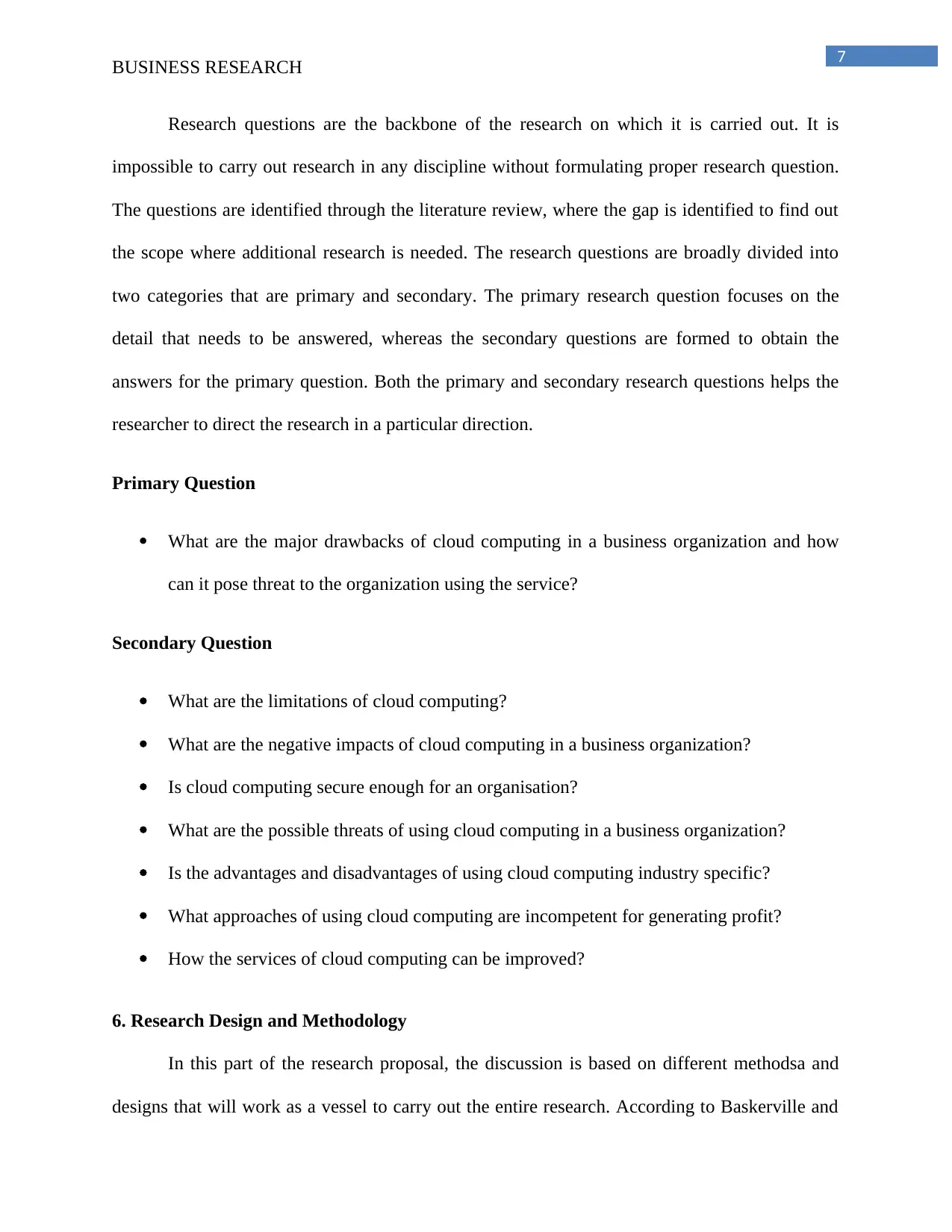
7
BUSINESS RESEARCH
Research questions are the backbone of the research on which it is carried out. It is
impossible to carry out research in any discipline without formulating proper research question.
The questions are identified through the literature review, where the gap is identified to find out
the scope where additional research is needed. The research questions are broadly divided into
two categories that are primary and secondary. The primary research question focuses on the
detail that needs to be answered, whereas the secondary questions are formed to obtain the
answers for the primary question. Both the primary and secondary research questions helps the
researcher to direct the research in a particular direction.
Primary Question
What are the major drawbacks of cloud computing in a business organization and how
can it pose threat to the organization using the service?
Secondary Question
What are the limitations of cloud computing?
What are the negative impacts of cloud computing in a business organization?
Is cloud computing secure enough for an organisation?
What are the possible threats of using cloud computing in a business organization?
Is the advantages and disadvantages of using cloud computing industry specific?
What approaches of using cloud computing are incompetent for generating profit?
How the services of cloud computing can be improved?
6. Research Design and Methodology
In this part of the research proposal, the discussion is based on different methodsa and
designs that will work as a vessel to carry out the entire research. According to Baskerville and
BUSINESS RESEARCH
Research questions are the backbone of the research on which it is carried out. It is
impossible to carry out research in any discipline without formulating proper research question.
The questions are identified through the literature review, where the gap is identified to find out
the scope where additional research is needed. The research questions are broadly divided into
two categories that are primary and secondary. The primary research question focuses on the
detail that needs to be answered, whereas the secondary questions are formed to obtain the
answers for the primary question. Both the primary and secondary research questions helps the
researcher to direct the research in a particular direction.
Primary Question
What are the major drawbacks of cloud computing in a business organization and how
can it pose threat to the organization using the service?
Secondary Question
What are the limitations of cloud computing?
What are the negative impacts of cloud computing in a business organization?
Is cloud computing secure enough for an organisation?
What are the possible threats of using cloud computing in a business organization?
Is the advantages and disadvantages of using cloud computing industry specific?
What approaches of using cloud computing are incompetent for generating profit?
How the services of cloud computing can be improved?
6. Research Design and Methodology
In this part of the research proposal, the discussion is based on different methodsa and
designs that will work as a vessel to carry out the entire research. According to Baskerville and
Paraphrase This Document
Need a fresh take? Get an instant paraphrase of this document with our AI Paraphraser
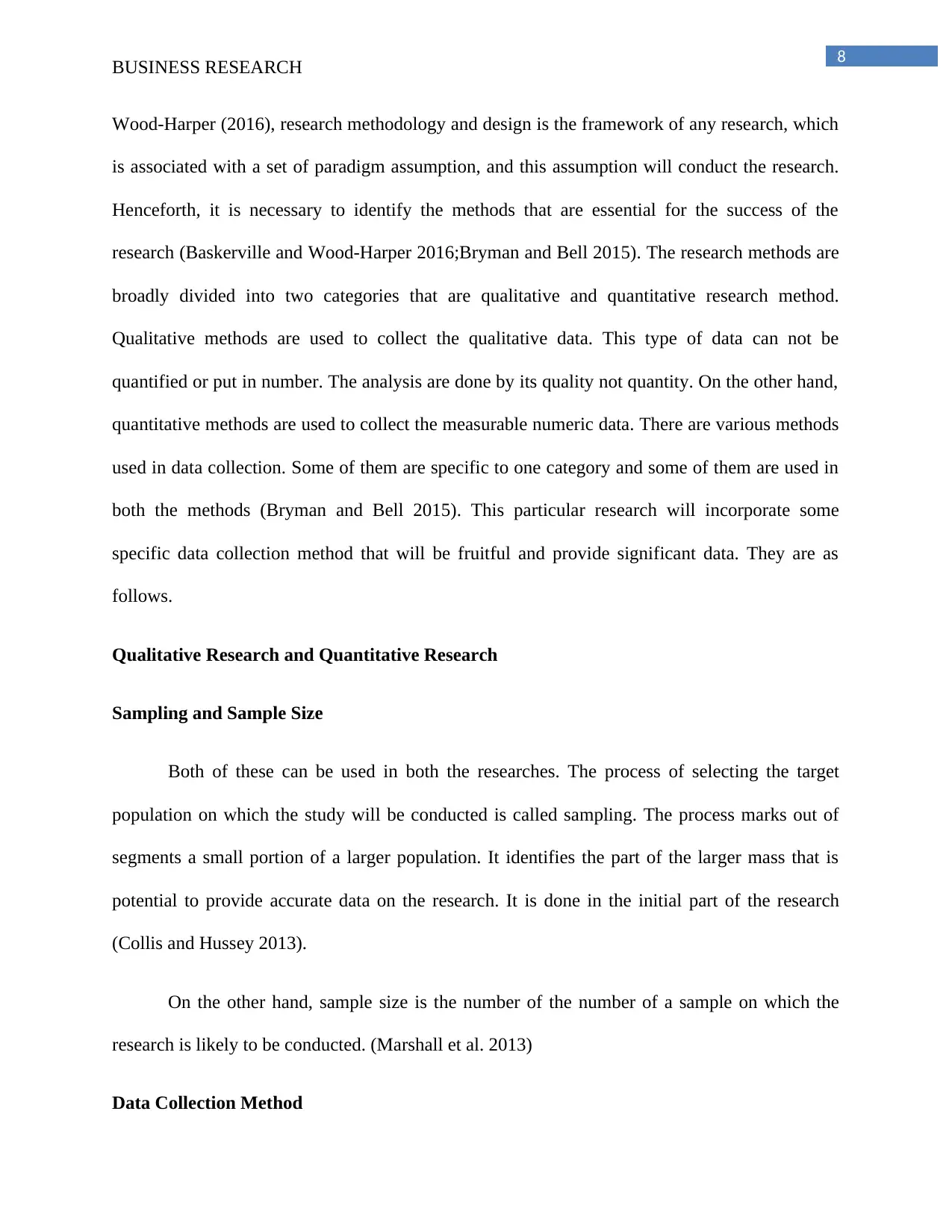
8
BUSINESS RESEARCH
Wood-Harper (2016), research methodology and design is the framework of any research, which
is associated with a set of paradigm assumption, and this assumption will conduct the research.
Henceforth, it is necessary to identify the methods that are essential for the success of the
research (Baskerville and Wood-Harper 2016;Bryman and Bell 2015). The research methods are
broadly divided into two categories that are qualitative and quantitative research method.
Qualitative methods are used to collect the qualitative data. This type of data can not be
quantified or put in number. The analysis are done by its quality not quantity. On the other hand,
quantitative methods are used to collect the measurable numeric data. There are various methods
used in data collection. Some of them are specific to one category and some of them are used in
both the methods (Bryman and Bell 2015). This particular research will incorporate some
specific data collection method that will be fruitful and provide significant data. They are as
follows.
Qualitative Research and Quantitative Research
Sampling and Sample Size
Both of these can be used in both the researches. The process of selecting the target
population on which the study will be conducted is called sampling. The process marks out of
segments a small portion of a larger population. It identifies the part of the larger mass that is
potential to provide accurate data on the research. It is done in the initial part of the research
(Collis and Hussey 2013).
On the other hand, sample size is the number of the number of a sample on which the
research is likely to be conducted. (Marshall et al. 2013)
Data Collection Method
BUSINESS RESEARCH
Wood-Harper (2016), research methodology and design is the framework of any research, which
is associated with a set of paradigm assumption, and this assumption will conduct the research.
Henceforth, it is necessary to identify the methods that are essential for the success of the
research (Baskerville and Wood-Harper 2016;Bryman and Bell 2015). The research methods are
broadly divided into two categories that are qualitative and quantitative research method.
Qualitative methods are used to collect the qualitative data. This type of data can not be
quantified or put in number. The analysis are done by its quality not quantity. On the other hand,
quantitative methods are used to collect the measurable numeric data. There are various methods
used in data collection. Some of them are specific to one category and some of them are used in
both the methods (Bryman and Bell 2015). This particular research will incorporate some
specific data collection method that will be fruitful and provide significant data. They are as
follows.
Qualitative Research and Quantitative Research
Sampling and Sample Size
Both of these can be used in both the researches. The process of selecting the target
population on which the study will be conducted is called sampling. The process marks out of
segments a small portion of a larger population. It identifies the part of the larger mass that is
potential to provide accurate data on the research. It is done in the initial part of the research
(Collis and Hussey 2013).
On the other hand, sample size is the number of the number of a sample on which the
research is likely to be conducted. (Marshall et al. 2013)
Data Collection Method
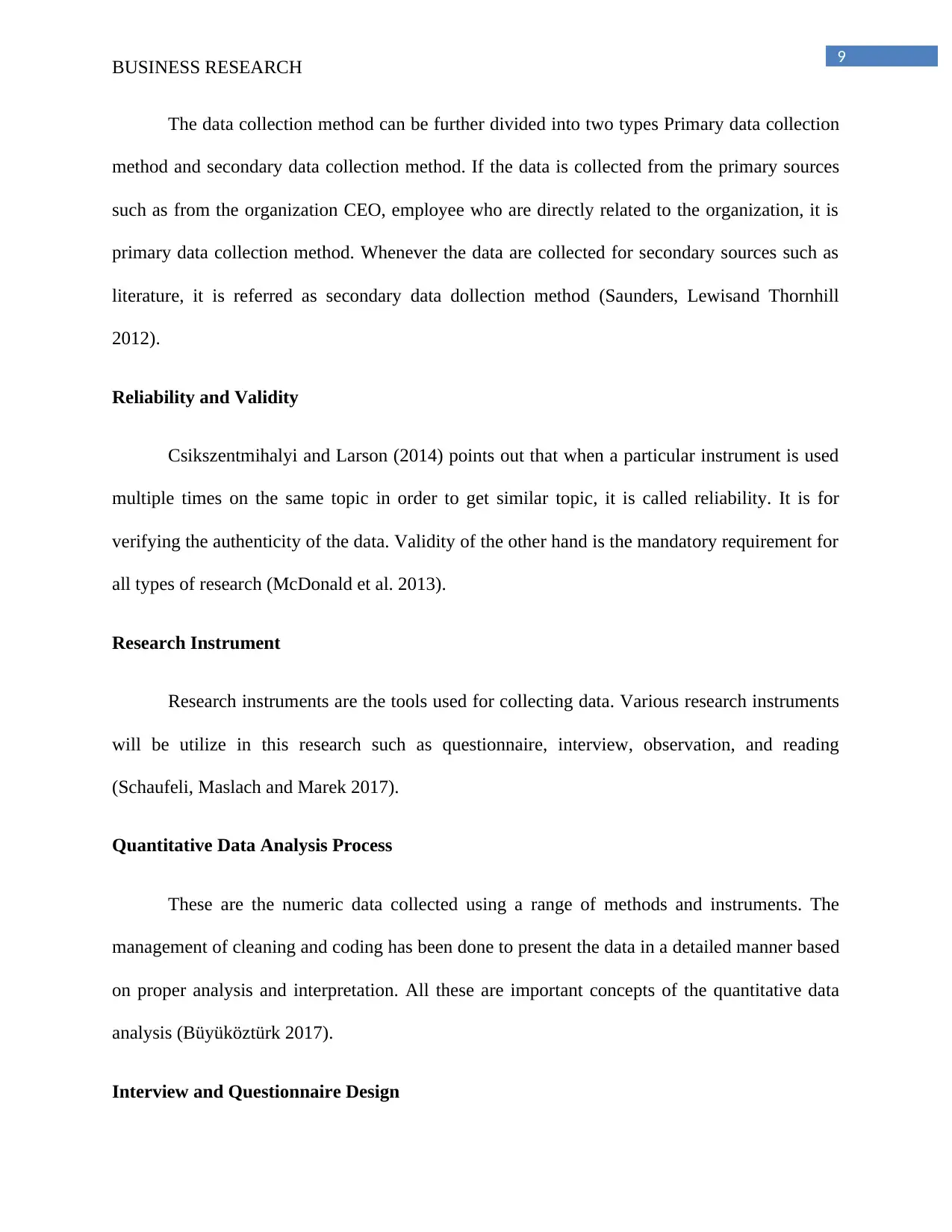
9
BUSINESS RESEARCH
The data collection method can be further divided into two types Primary data collection
method and secondary data collection method. If the data is collected from the primary sources
such as from the organization CEO, employee who are directly related to the organization, it is
primary data collection method. Whenever the data are collected for secondary sources such as
literature, it is referred as secondary data dollection method (Saunders, Lewisand Thornhill
2012).
Reliability and Validity
Csikszentmihalyi and Larson (2014) points out that when a particular instrument is used
multiple times on the same topic in order to get similar topic, it is called reliability. It is for
verifying the authenticity of the data. Validity of the other hand is the mandatory requirement for
all types of research (McDonald et al. 2013).
Research Instrument
Research instruments are the tools used for collecting data. Various research instruments
will be utilize in this research such as questionnaire, interview, observation, and reading
(Schaufeli, Maslach and Marek 2017).
Quantitative Data Analysis Process
These are the numeric data collected using a range of methods and instruments. The
management of cleaning and coding has been done to present the data in a detailed manner based
on proper analysis and interpretation. All these are important concepts of the quantitative data
analysis (Büyüköztürk 2017).
Interview and Questionnaire Design
BUSINESS RESEARCH
The data collection method can be further divided into two types Primary data collection
method and secondary data collection method. If the data is collected from the primary sources
such as from the organization CEO, employee who are directly related to the organization, it is
primary data collection method. Whenever the data are collected for secondary sources such as
literature, it is referred as secondary data dollection method (Saunders, Lewisand Thornhill
2012).
Reliability and Validity
Csikszentmihalyi and Larson (2014) points out that when a particular instrument is used
multiple times on the same topic in order to get similar topic, it is called reliability. It is for
verifying the authenticity of the data. Validity of the other hand is the mandatory requirement for
all types of research (McDonald et al. 2013).
Research Instrument
Research instruments are the tools used for collecting data. Various research instruments
will be utilize in this research such as questionnaire, interview, observation, and reading
(Schaufeli, Maslach and Marek 2017).
Quantitative Data Analysis Process
These are the numeric data collected using a range of methods and instruments. The
management of cleaning and coding has been done to present the data in a detailed manner based
on proper analysis and interpretation. All these are important concepts of the quantitative data
analysis (Büyüköztürk 2017).
Interview and Questionnaire Design
⊘ This is a preview!⊘
Do you want full access?
Subscribe today to unlock all pages.

Trusted by 1+ million students worldwide
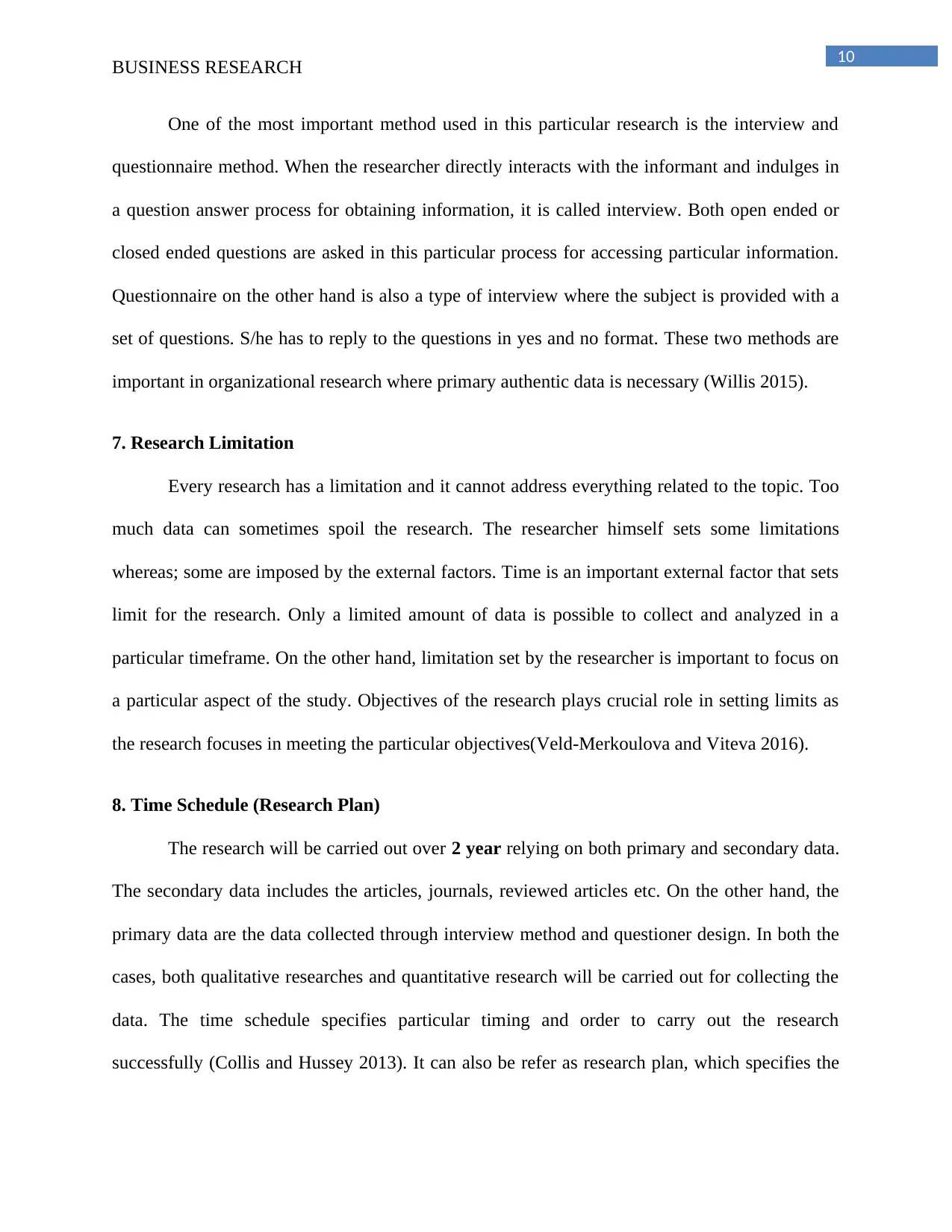
10
BUSINESS RESEARCH
One of the most important method used in this particular research is the interview and
questionnaire method. When the researcher directly interacts with the informant and indulges in
a question answer process for obtaining information, it is called interview. Both open ended or
closed ended questions are asked in this particular process for accessing particular information.
Questionnaire on the other hand is also a type of interview where the subject is provided with a
set of questions. S/he has to reply to the questions in yes and no format. These two methods are
important in organizational research where primary authentic data is necessary (Willis 2015).
7. Research Limitation
Every research has a limitation and it cannot address everything related to the topic. Too
much data can sometimes spoil the research. The researcher himself sets some limitations
whereas; some are imposed by the external factors. Time is an important external factor that sets
limit for the research. Only a limited amount of data is possible to collect and analyzed in a
particular timeframe. On the other hand, limitation set by the researcher is important to focus on
a particular aspect of the study. Objectives of the research plays crucial role in setting limits as
the research focuses in meeting the particular objectives(Veld-Merkoulova and Viteva 2016).
8. Time Schedule (Research Plan)
The research will be carried out over 2 year relying on both primary and secondary data.
The secondary data includes the articles, journals, reviewed articles etc. On the other hand, the
primary data are the data collected through interview method and questioner design. In both the
cases, both qualitative researches and quantitative research will be carried out for collecting the
data. The time schedule specifies particular timing and order to carry out the research
successfully (Collis and Hussey 2013). It can also be refer as research plan, which specifies the
BUSINESS RESEARCH
One of the most important method used in this particular research is the interview and
questionnaire method. When the researcher directly interacts with the informant and indulges in
a question answer process for obtaining information, it is called interview. Both open ended or
closed ended questions are asked in this particular process for accessing particular information.
Questionnaire on the other hand is also a type of interview where the subject is provided with a
set of questions. S/he has to reply to the questions in yes and no format. These two methods are
important in organizational research where primary authentic data is necessary (Willis 2015).
7. Research Limitation
Every research has a limitation and it cannot address everything related to the topic. Too
much data can sometimes spoil the research. The researcher himself sets some limitations
whereas; some are imposed by the external factors. Time is an important external factor that sets
limit for the research. Only a limited amount of data is possible to collect and analyzed in a
particular timeframe. On the other hand, limitation set by the researcher is important to focus on
a particular aspect of the study. Objectives of the research plays crucial role in setting limits as
the research focuses in meeting the particular objectives(Veld-Merkoulova and Viteva 2016).
8. Time Schedule (Research Plan)
The research will be carried out over 2 year relying on both primary and secondary data.
The secondary data includes the articles, journals, reviewed articles etc. On the other hand, the
primary data are the data collected through interview method and questioner design. In both the
cases, both qualitative researches and quantitative research will be carried out for collecting the
data. The time schedule specifies particular timing and order to carry out the research
successfully (Collis and Hussey 2013). It can also be refer as research plan, which specifies the
Paraphrase This Document
Need a fresh take? Get an instant paraphrase of this document with our AI Paraphraser
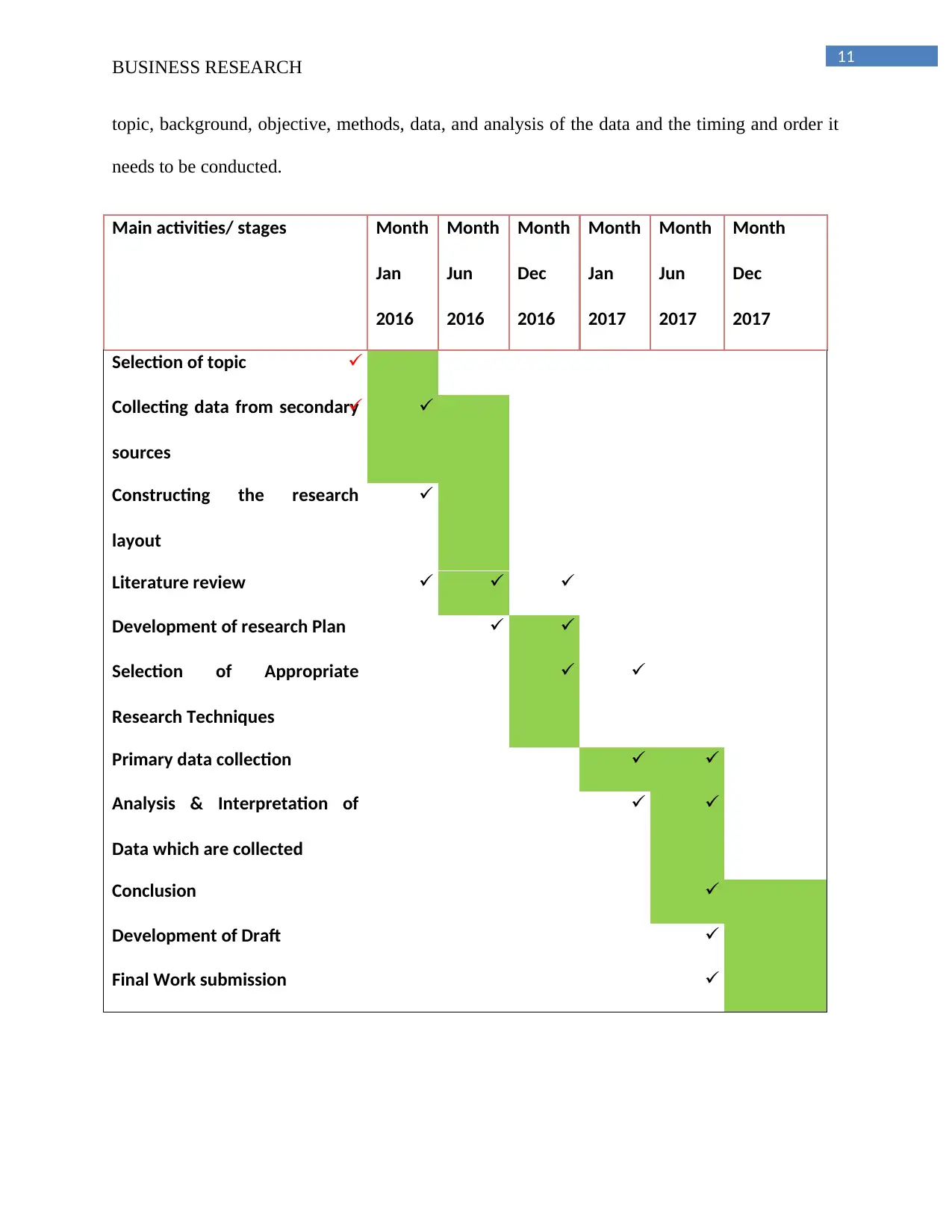
11
BUSINESS RESEARCH
topic, background, objective, methods, data, and analysis of the data and the timing and order it
needs to be conducted.
Main activities/ stages Month
Jan
2016
Month
Jun
2016
Month
Dec
2016
Month
Jan
2017
Month
Jun
2017
Month
Dec
2017
Selection of topic
Collecting data from secondary
sources
Constructing the research
layout
Literature review
Development of research Plan
Selection of Appropriate
Research Techniques
Primary data collection
Analysis & Interpretation of
Data which are collected
Conclusion
Development of Draft
Final Work submission
BUSINESS RESEARCH
topic, background, objective, methods, data, and analysis of the data and the timing and order it
needs to be conducted.
Main activities/ stages Month
Jan
2016
Month
Jun
2016
Month
Dec
2016
Month
Jan
2017
Month
Jun
2017
Month
Dec
2017
Selection of topic
Collecting data from secondary
sources
Constructing the research
layout
Literature review
Development of research Plan
Selection of Appropriate
Research Techniques
Primary data collection
Analysis & Interpretation of
Data which are collected
Conclusion
Development of Draft
Final Work submission
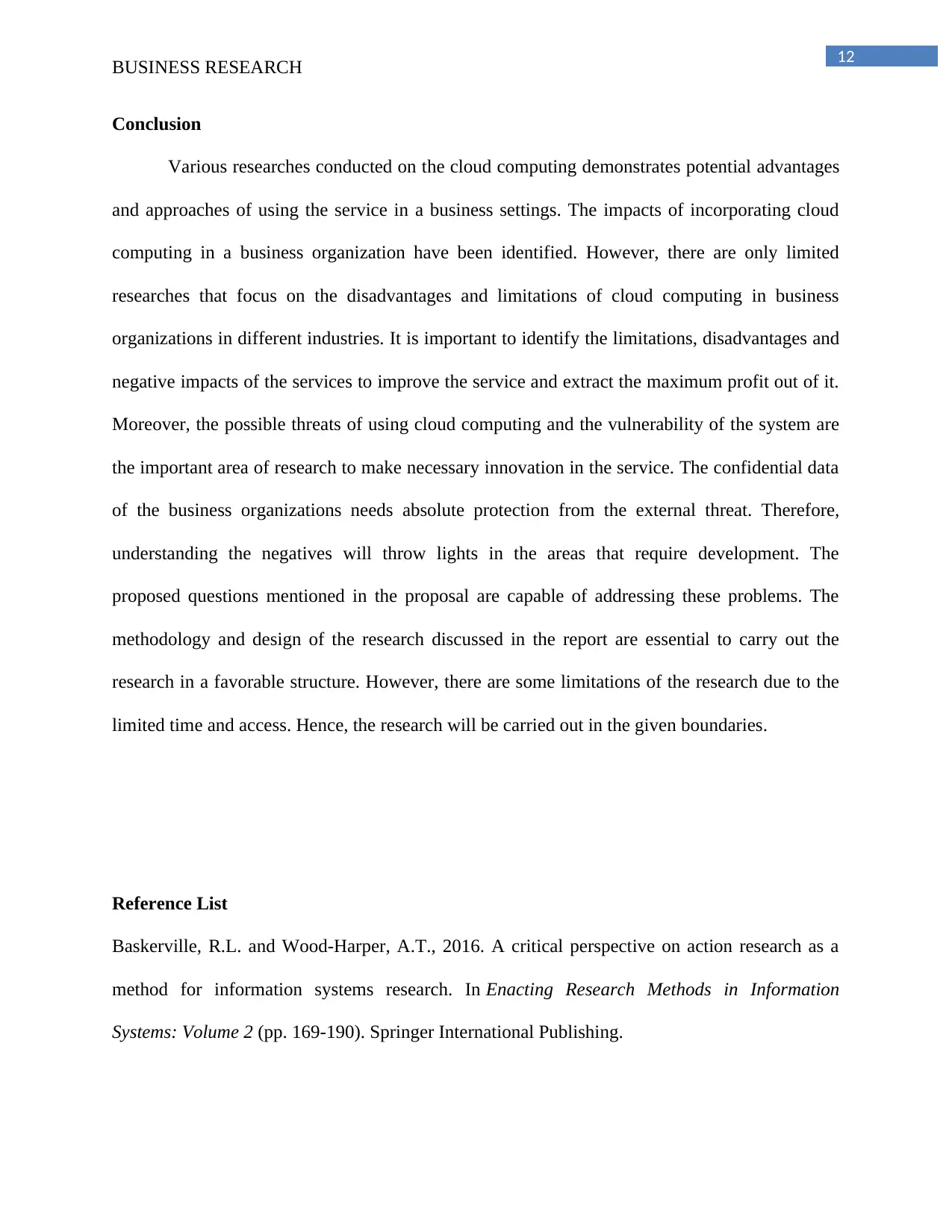
12
BUSINESS RESEARCH
Conclusion
Various researches conducted on the cloud computing demonstrates potential advantages
and approaches of using the service in a business settings. The impacts of incorporating cloud
computing in a business organization have been identified. However, there are only limited
researches that focus on the disadvantages and limitations of cloud computing in business
organizations in different industries. It is important to identify the limitations, disadvantages and
negative impacts of the services to improve the service and extract the maximum profit out of it.
Moreover, the possible threats of using cloud computing and the vulnerability of the system are
the important area of research to make necessary innovation in the service. The confidential data
of the business organizations needs absolute protection from the external threat. Therefore,
understanding the negatives will throw lights in the areas that require development. The
proposed questions mentioned in the proposal are capable of addressing these problems. The
methodology and design of the research discussed in the report are essential to carry out the
research in a favorable structure. However, there are some limitations of the research due to the
limited time and access. Hence, the research will be carried out in the given boundaries.
Reference List
Baskerville, R.L. and Wood-Harper, A.T., 2016. A critical perspective on action research as a
method for information systems research. In Enacting Research Methods in Information
Systems: Volume 2 (pp. 169-190). Springer International Publishing.
BUSINESS RESEARCH
Conclusion
Various researches conducted on the cloud computing demonstrates potential advantages
and approaches of using the service in a business settings. The impacts of incorporating cloud
computing in a business organization have been identified. However, there are only limited
researches that focus on the disadvantages and limitations of cloud computing in business
organizations in different industries. It is important to identify the limitations, disadvantages and
negative impacts of the services to improve the service and extract the maximum profit out of it.
Moreover, the possible threats of using cloud computing and the vulnerability of the system are
the important area of research to make necessary innovation in the service. The confidential data
of the business organizations needs absolute protection from the external threat. Therefore,
understanding the negatives will throw lights in the areas that require development. The
proposed questions mentioned in the proposal are capable of addressing these problems. The
methodology and design of the research discussed in the report are essential to carry out the
research in a favorable structure. However, there are some limitations of the research due to the
limited time and access. Hence, the research will be carried out in the given boundaries.
Reference List
Baskerville, R.L. and Wood-Harper, A.T., 2016. A critical perspective on action research as a
method for information systems research. In Enacting Research Methods in Information
Systems: Volume 2 (pp. 169-190). Springer International Publishing.
⊘ This is a preview!⊘
Do you want full access?
Subscribe today to unlock all pages.

Trusted by 1+ million students worldwide
1 out of 13
Related Documents
Your All-in-One AI-Powered Toolkit for Academic Success.
+13062052269
info@desklib.com
Available 24*7 on WhatsApp / Email
![[object Object]](/_next/static/media/star-bottom.7253800d.svg)
Unlock your academic potential
Copyright © 2020–2025 A2Z Services. All Rights Reserved. Developed and managed by ZUCOL.





